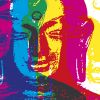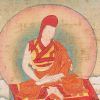
Seeing through the eyes of the thirteenth-century Zen master Eihei Dogen
Most schools of Buddhism are quite strict about not seeing reality as something outside of ourselves, as something separate from our minds. Buddhist practice allows us to see how the way we view the world is cognized and conditioned. As such the mind releases its grip, eventually seeing that there is no solid, permanent reality. While we tend to understand reality as unfolding in linear and cyclical ways, even those frames we call time begin to loosen and lose their ground. When they fall away, our sense of time sometimes disappears too. There is no here nor there, no passing, no aging, no coming and going—only the whole of being, still, silent, vast, and complete. In this no-time there is only freedom, nothing against which we compare ourselves.
The thirteenth-century Soto Zen ancestor Eihei Dogen offers another way to see time. Dogen encourages us to understand time as inseparable from being. We are not beings in time—linear, cyclical, or otherwise. All of being arises and falls away together in any given moment, arising and falling again in the next moment. There is not an isolatable human life in one moment that becomes the isolatable human life in the next moment. There is no tree of one moment that causes the tree of the next moment. Rather, all of existence arises and falls away in each moment. Grasping the experience of separate events continuously across time is a mistake of the mind. In the Genjo Koan, Dogen writes:
Death does not turn into birth. Accordingly, death is understood as no-death. Birth is an expression complete this moment. Death is an expression complete this moment. They are like winter and spring. You do not call winter the beginning of spring, nor summer the end of spring.
In other words, we may think of something becoming something else, but we should see each moment as a complete arising unto itself, each being as an expression of time, as all of being and all of time. In his fascicle Uji, Dogen similarly notes:
Spring invariably flows through spring. Although flowing itself is not
spring, flowing occurs throughout spring. Thus, flowing is completed at just
this moment of spring. Examine this thoroughly, coming and going.
In your study of flowing, if you imagine the objective to be outside
yourself and that you flow and move through hundreds and thousands of
worlds, for hundreds, thousands, and myriads of eons, you have not devotedly
studied the Buddha way.
Dogen encourages us not to make the mistake of seeing flowing as something separate from that which flows. Time is not something outside yourself. We are unfolding as being-time, with no way of separating being from time or time from being. This is time as experienced by the body without attachment to our frames of time.
He also writes, “The way the self arrays itself is the form of the entire world. See each thing in this entire world as a moment of time.” Time unfolds as every being. Time is not a reality outside of us in which we are moving. Time is unfolding as all being, each being unfolding in its time, and all being unfolding as time.
What does this mean for us in our everyday lives? When we experience time as something separate, something we are up against, we confuse our world and cause suffering. We are the full expression of time, with nothing to do other than be that expression. When we frame time, we use a set of concepts to be skillful in the world, to manifest our bodhisattva vow to save all beings. We use linear time to save all beings. We use cyclical time to save all beings.
As Buddhists our work is to realize the immediate timelessness of existence and live the understanding that time and being are forever arising together as a complete whole in every moment. With this understanding, we are already free, and from this freedom we skillfully engage the conceptual frames of linear and cyclical time without grasping them. We do this for the sake of all beings, to end suffering for everyone.
Without framing time in some way, we cannot find our way together in this human world. If we grasp any of those frames, however, we will be lost in our shared, karmic existence, unconsciously passing on the tension and violence of a tight, hurried mind unavailable to the suffering of humanity. We will be much like the man in Milarepa’s story, who, carried away by a torrent, pretended to save others.
Dogen ends Uji by telling us “to study thoroughly” this “coming and going” and “arriving and not-arriving,” for it is the study itself that “is the time-being of this moment.” It is through this study that, over time, we find our deepest freedom alongside the wisdom and skill to devote ourselves to the benefit of all life.
About the Contributor
Greg Snyder is the senior director of Buddhist studies at Union Theological Seminary, where he directs and teaches in the masters of divinity program focused on Buddhism and interreligious engagement. He is also a dharma teacher and senior priest at the Brooklyn Zen Center, as well as its cofounder and current president.





